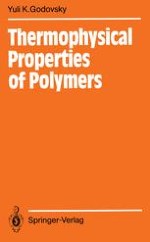1992 | OriginalPaper | Chapter
Thermal Expansion
Author : Prof. Dr. Yuli K. Godovsky
Published in: Thermophysical Properties of Polymers
Publisher: Springer Berlin Heidelberg
Included in: Professional Book Archive
Activate our intelligent search to find suitable subject content or patents.
Select sections of text to find matching patents with Artificial Intelligence. powered by
Select sections of text to find additional relevant content using AI-assisted search. powered by
Thermal expansion, or more widely thermal deformation, is characterized by the changes of the dimensions of a body resulting from the temperature changes. Similar to the thermal conductivity, the thermal expansivity occurs due to anharmonicity of various modes of lattice vibrations [1, 2]. Any formulations concerning the thermal expansivity of solids are closely related to the main ideas of an equation of state for solids. According to the original Gruneisen assumption [1] the internal energy of a solid can be divided into a static and athermal portion. This assumption leads to an equation of state for the pressure which contains two terms: one of the terms corresponds to the static interaction (internal pressure) and the other represents the thermal pressure due to the expansivity of the lattice vibrations. Thus, the most widely used form of the equation of state for solids is (3.1)$$P = {P_i} + \gamma {P_T}$$ which corresponds to the usual Mie-Gruneisen approximation. In this equation Pi = -dUL/dV is the internal pressure, γ is the Gruneisen parameter, PT = Ut/V is the thermal pressure, and UT is the thermal energy. Differentiation of Eq. (3.1) with respect to temperature at constant volume yields (3.2)$${\left( {\frac{{\partial P}}{{\partial T}}} \right)_v} = \alpha {K_T} = \gamma \frac{{{C_v}}}{V}$$ where α is the thermal expansion coefficient, and KT is the isothermal bulk modulus.
